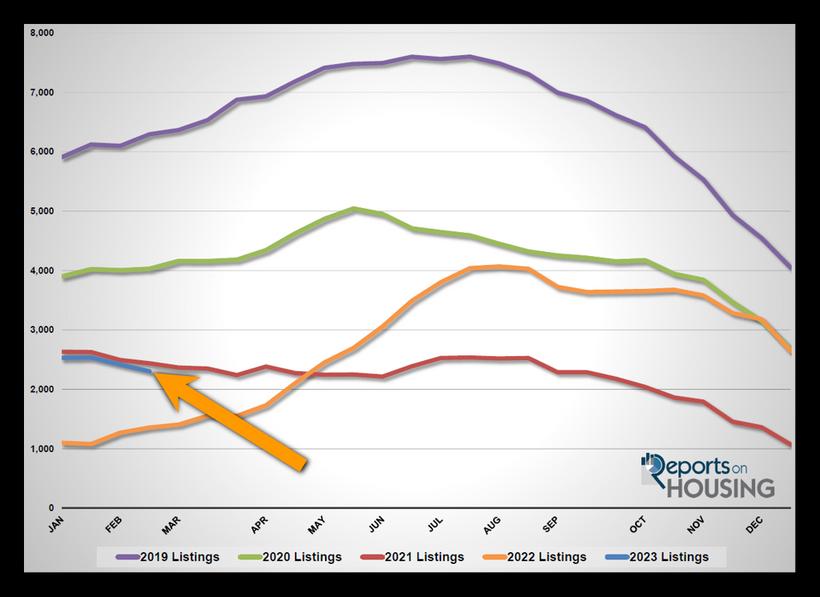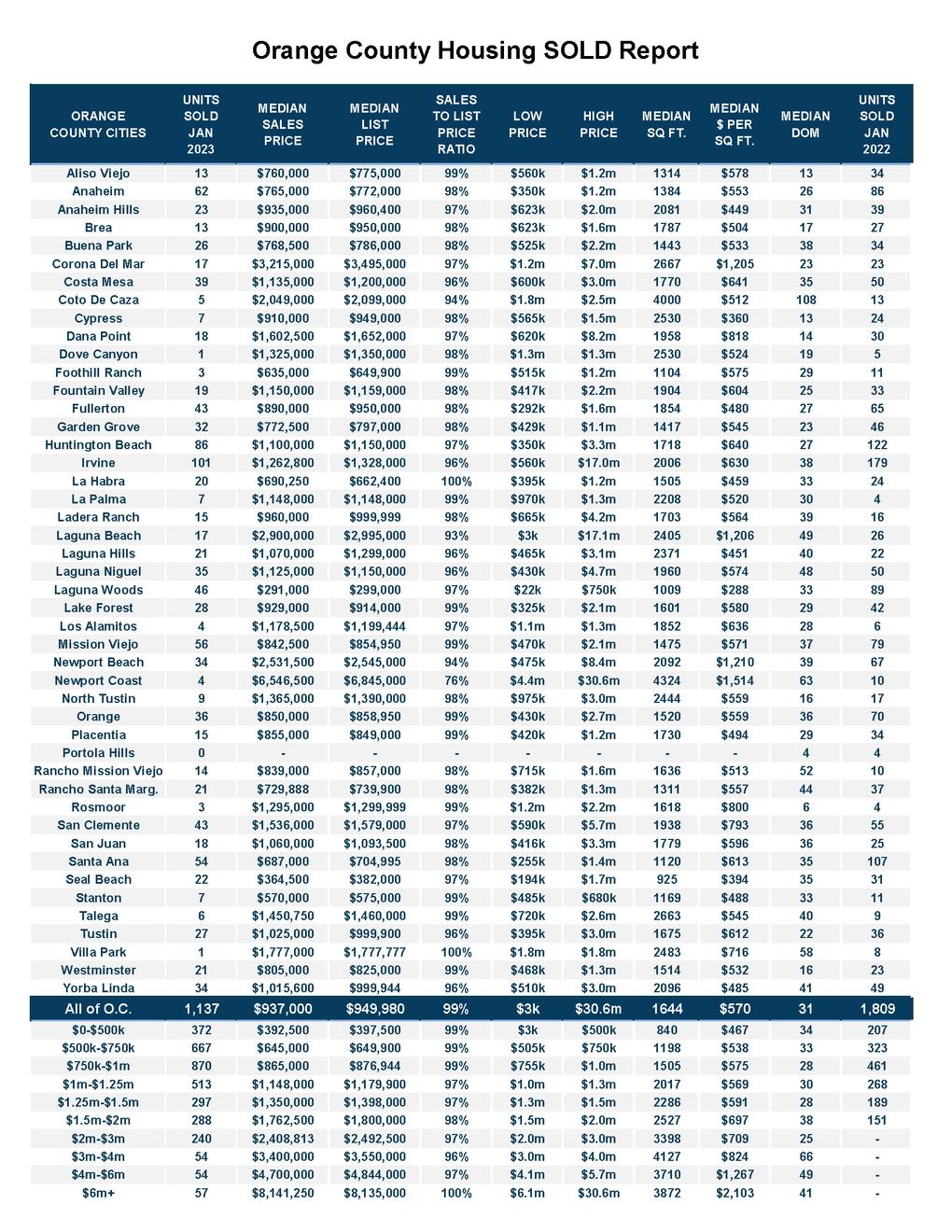Rates Pave Path for Housing


IT IS ALL ABOUT RATES IN THE HOUSING MARKET, FROM THE NUMBER OF HOMEOWNERS WILLING TO SELL TO THE VOLUME OF BUYERS ABLE TO AFFORD TO PURCHASE




IT IS ALL ABOUT RATES IN THE HOUSING MARKET, FROM THE NUMBER OF HOMEOWNERS WILLING TO SELL TO THE VOLUME OF BUYERS ABLE TO AFFORD TO PURCHASE

Just about everyone loves the beach. Basking in the sun, walking along the coast, listening to the soothing sounds of waves crashing on the shore, and taking a refreshing plunge in the cool, salty water, are some of the many reasons so many head to the beach, especially on the weekend. Yet, what happens when it is overcast and cool during the winter? Not as many Southern Californians make the pilgrimage to the beach. There are still plenty of beachgoers when it is cool, from die-hard surfers in their winter wetsuits to locals taking a walk or jogging on the sand. Still, there is a definitive difference between the hot summer days and the crispy winter weather with the wind blowing and temps in the 50s. There are times when beaches seem almost deserted.
Similarly, when mortgage rates are low, the market heats up with a rise in affordability and buyer demand, along with a surge of homeowners desirous of taking advantage of a great time to make a move. Yet, when mortgage rates substantially rise as they did over the past year, demand diminishes due to affordability constraints, and many sellers opt to “hunker down” as they enjoy their underlying, locked-in, low fixed-rate mortgages.
The pandemic was an enormous disruptor, and housing benefited profoundly due to the involvement of the Federal Reserve and the Federal Government. The Fed brought the Federal Funds Rate to zero and bought trillions of dollars of both mortgage-backed securities and treasuries. Mortgage rates dropped to record low levels, instigating tremendous housing demand. The Federal Government passed stimulus packages that sent checks directly to United States citizens. Bank accounts swelled and enabled many buyers to achieve their dream of homeownership. Mortgage rates remained at unbelievably low levels, and housing benefited with a nearly instantaneous, insanely hot market that lasted for two years, from June 2020 to May 2022. That is when the Federal Reserve stepped in and started hiking rates and reducing the number of mortgagebacked securities on their books. Mortgage rates soared, and the Fed slammed on the housing market’s brakes.
In 2022, mortgage rates started the year at about 3.25%, according to Mortgage News Daily, and surpassed 7% in both October and November. It was a constant erosion of purchasing power for buyers looking to purchase. Last year’s giant jump in rates had a significant impact on affordability. For example, buyers desirous of a $4,000 per month principal and interest payment with 10% down started the year looking at a $1,021,111 home. By October, with rates above 7%, the same buyer was looking at a $665,000 home.


Understandably, rising rates sideline many buyers. Yet, since November, mortgage rates have remained below 7% with duration, inviting many buyers to begin their search for a home again. They averaged 6.3% in December, 6.2% in January, and 6.5% thus far in February. Recently, a series of positive economic reports, which is not helpful in the Fed’s inflation fight, has resulted in rising rates, reaching 6.87% today.
Nonetheless, as the economy eventually slows, mortgage rates are anticipated to fall. As they fall, affordability will improve, and demand will rise. In looking at that same desired $4,000 monthly payment, a drop from 7% to 6% allows a buyer to increase their search from a $667,778 home to one at $741,111. Rates could reach 5.5% in the summer if inflation falls and the economy cools, which would allow that buyer to broaden their search to $782,222. As rates drop, affordability improves, allowing more purchasers to enter the housing arena.
Higher rates sideline many sellers as well. Some homeowners would like to move but choose to “hunker down” and stay put instead. Their current underlying low, fixed-rate mortgage is preventing them from selling. Since 89% of all California homeowners with a mortgage have a rate at or below 5%, and 71% have a rate at or below 4%, the higher rate environment limits the number of sellers coming on the market. In Orange County in 2022, there were 22% fewer sellers, 8,500 missing FOR-SALE signs due to the hunkering down trend. In January, there were 45% fewer sellers, or 1,375 missing signs. That is a big chunk of the housing market. As rates drop, the gap between a homeowner’s underlying rate decreases. When rates eventually drop below 5.5%, that gap will narrow enough to entice many homeowners to sell, and fewer homeowners will continue to hunker down.
The missing sellers have resulted in a falling inventory despite lower demand levels. Demand, the last month of pending sales activity, is at 1,537, readings last seen during the April 2020 lockdowns of the pandemic. Yet, there are only 2,305 homes available today, an anemic reading well off the 3-year pre-pandemic average for mid-February (2017 to 2019) of 4,834 homes, more than double where it stands today. As a result, the market feels exceptionally hot even with higher rates with an Expected Market Time, the time between listing and successfully negotiating a contract to sell, of only 45 days. The 3-year pre-COVID average was 63 days. Today’s hotter market is a function of the low supply and fewer homeowners coming to market, not record-breaking demand.
Mortgage rates pave the path for housing. Substantially higher rates have been limiting supply and demand, constraining the number of closed sales. As rates drop, demand rises, more homeowners opt to sell, and more closed sales will occur.
The active listing inventory decreased by 110 homes in the past couple of weeks, down 5%, and now sits at 2,305 homes, its lowest level since April of last year. The inventory typically climbs slowly in February. The 3-year pre-COVID average (2017 to 2019) was a 3% rise. The inventory is following the post-pandemic trend in 2021 of a declining inventory to start the year. Surging demand is only slightly to blame for the decreasing supply. Instead, the lack of homes coming on the market is the main culprit for the anemic supply. In January, 1,680 new sellers came on the market in Orange County, 1,375 fewer than the 3-year average before COVID (2017 to 2019), 45% less. These missing sellers are preventing the inventory from meaningfully growing. In March, as housing transitions into the Spring Market, more sellers will come on the market, but it will be muted as homeowners continue to “hunker down,” unwilling to move due to their current underlying, low fixed-rate mortgage.

Last year, the inventory was 1,358, 41% lower, or 947 fewer. The 3-year average before COVID (2017 through 2019) is 4,977, an additional 2,672 homes, or 116% extra, more than double today.

With demand surging higher and the supply falling, the Expected Market Time (the number of days to sell all Orange County listings at the current buying pace) plunged from 56 to 45 days in the past couple of weeks, its lowest level since the start of June 2022. Last year the Expected Market Time was 20 days, substantially faster than today, and home values were screaming higher. The 3-year average before COVID was 64 days, a slower pace than today.



In the past couple of weeks, the luxury inventory of homes priced above $2 million increased from 592 to 606 homes, up 14 homes, or 2%. Luxury demand increased by 26 pending sales, up 21%, and now sits at 150, its highest level since October. With supply only increasing slightly compared to surging demand, the Expected Market Time for luxury homes priced above $2 million decreased from 143 to 121 days, its strongest level since the start of September. The luxury market is not quite as slow as before COVID but is not as fast as in the past couple of years either. Expect the luxury market to continue improving over the next several weeks.
Year over year, luxury demand is down by 94 pending sales or 39%, and the active luxury listing inventory is up by 243 homes or 67%. Last year’s Expected Market Time was 45 days, nearly instantaneous for luxury.

For homes priced between $2 million and $4 million, the Expected Market Time in the past two weeks decreased from 98 to 82 days. For homes priced between $4 million and $6 million, the Expected Market Time decreased from 225 to 216 days. For homes priced above $6 million, the Expected Market Time decreased from 523 to 347 days. At 347 days, a seller would be looking at placing their home into escrow around February 2024


This range represents 24% of the active inventory and 28% of demand.
For homes priced between $750,000 and $1 million, the Expected Market Time decreased from 41 to 32 days. This range represents 19% of the active inventory and 27% of demand.
For homes priced between $1 million to $1.25 million, the Expected Market Time decreased from 47 to 33 days. This range represents 10% of the active inventory and 14% of demand.
For homes priced between $1.25 million to $1.5 million, the Expected Market Time decreased from 55 to 45 days. This range represents 10% of the active inventory and 10% of demand.

For homes priced between $1 5 million to $2 million, the Expected Market Time decreased from 62 to 44 days This range represents 10% of the active inventory and 11% of demand
For homes priced between $2 million and $4 million, the Expected Market Time in the past two weeks decreased from 98 to 82 days For homes priced between $4 million and $6 million, the Expected Market Time decreased from 225 to 216 days For homes priced above $6 million, the Expected Market Time decreased from 523 to 347 days
The luxury end, all homes above $2 million, account for 26% of the inventory and 10% of demand
Distressed homes, both short sales and foreclosures combined, comprised only 0.3% of all listings and 0.2% of demand. There are only three foreclosures and five short sales available to purchase today in all of Orange County, with eight total distressed homes on the active market, up one from two weeks ago. Last year there were three total distressed homes on the market, similar to today.
There were 1,137 closed residential resales in January, 37% less than January 2022’s 1,809 closed sales. January marked an 18% decrease compared to December 2022. The sales-to-list price ratio was 98.6% for all of Orange County. Foreclosures accounted for 0.4% of all closed sales, and short sales accounted for 0.1%. That means that 99.5% of all sales were good ol’ fashioned sellers with equity






